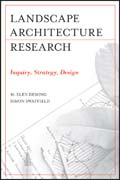
Landscape architectural research: inquiry, strategy, design
Deming, Elen M.
Swaffield, Simon
INDICE: Preface. Acknowledgments. Chapter 1 Introduction. 1.1 Knowledge in Landscape Architecture. 1.2 The need for a guide. 1.3 The Gatekeeping Dilemma:Towards a contextual approach to knowledge formation and validation. 1.4. Research Strategies in Landscape Architecture: Mapping the terrain. 1.5. Buildinga research based discipline. Chapter 2 Knowing Landscape Architecture. 2.1 Introduction. 2.2 The nature of professional disciplines. 2.3 Domains of Knowledge in Landscape Architecture. 2.4 Research Needs. Chapter 3 Theory/ Research/ Scholarship/ Critique. 3.1 Introduction. 3.2 Competing ideals of theory. 3.3 Representing Theory. 3.4 Theoretical conversations. 3.5 Research and scholarship. 3.6 Studio design as a research setting. 3.7 Theory and Critique. 3.8 Conclusion. Chapter 4 Integrating Design and Research. 4.1 Introduction. 4.2 Problems and Purpose. 4.3. Framing a research questions. 4.4 Degrees of Research. 4.5 Assessing Research Quality. 4.6 A Developmental Heuristic. Chapter 5 Descriptive Strategies. 5.1 Introduction. 5.2 Observation. 5.3 Secondary Description.5.4 Descriptive Social Surveys. 5.5 Complex Description. 5.6 Descriptive CaseStudies. Descriptive Strategies Summary. Chapter 6 Modelling and Correlational Strategies. 6.1 Introduction. 6.2 Descriptive/Synthetic Models. 6.3 Analytical Models and Correlation. 6.4 Simple correlation. 6.5 Multiple Correlations. 6.6 Spatial Correlations. 6.7 Predictive Modelling. 6.8 Dynamic Simulation Modelling. Modelling Strategies: Summary. Chapter 7 Experimental Strategies. 7.1 Introduction. 7.2 Classic Experiments. 7.3 Field Experiments. 7.4 Quasi-experiments. 7.5 The metaphor of experimentation. Experimentation: Summary. Chapter 8 Classification Schemes. 8.1 Introduction: Separating apples from oranges. 8.2 Collection/Inventory/Catalogue. 8.3 Typology. 8.4 Taxonomy. 8.5 Index. 8.6 Bibliography & Literature Review. Classification Strategies Summary. Chapter 9 Interpretive Strategies. 9.1 Introduction. 9.2 Ethnography. 9.3 Discourse Analysis. 9.4 Iconology and Iconography. 9.5 Historiography. Interpretative Strategies: Summary. Chapter 10 Evaluation and Diagnosis. 10.1 Introduction. 10.2 Parameters, norms and rubrics. 10.3 Design Evaluation. 10.4 Diagnostics. 10.5 Visual assessment. Evaluation and Diagnostics Strategies Summary. Chapter 11 Engaged Action Research. 11.1 Introduction. 11.2 Action dimensions in pedagogicalresearch. 11.3 Participatory Action Research (PAR). 11.4 Participatory Designin Service Learning. 11.5 Transdisciplinary action research (TDAR). Participatory action research strategies: Summary. Chapter 12: Projective Design. 12.1 Is Design Research? 12.2 Reflection-in-Action. 12.3 Design Methods. 12.4 Interpretive Methodologies. 12.5 Developmental Methodologies. 12.6 Exploratory Methods. Chapter Summary.
- ISBN: 978-0-470-56417-2
- Editorial: John Wiley & Sons
- Encuadernacion: Rústica
- Páginas: 256
- Fecha Publicación: 09/03/2011
- Nº Volúmenes: 1
- Idioma: Inglés
